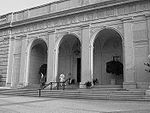Smithsonian Institution

The Smithsonian Institution ( smith-SOH-nee-ən), or simply the Smithsonian, is a group of museums and education and research centers, the largest such complex in the world, created by the U.S. government "for the increase and diffusion of knowledge". Founded on August 10, 1846, it operates as a trust instrumentality and is not formally a part of any of the three branches of the federal government. The institution is named after its founding donor, British scientist James Smithson. It was originally organized as the United States National Museum, but that name ceased to exist administratively in 1967.Called "the nation's attic" for its eclectic holdings of 154 million items, the institution's 19 museums, 21 libraries, nine research centers, and zoo include historical and architectural landmarks, mostly located in the District of Columbia. Additional facilities are located in Maryland, New York, and Virginia. More than 200 institutions and museums in 45 states, Puerto Rico, and Panama are Smithsonian Affiliates. Institution publications include Smithsonian and Air & Space magazines. The institution's 30 million annual visitors are admitted without charge. Its annual budget is around $1.25 billion, with two-thirds coming from annual federal appropriations. Other funding comes from the institution's endowment, private and corporate contributions, membership dues, and earned retail, concession, and licensing revenue. As of 2021, the institution's endowment had a total value of about $5.4 billion.
Excerpt from the Wikipedia article Smithsonian Institution (License: CC BY-SA 3.0, Authors, Images).Smithsonian Institution
Jefferson Drive Southwest, Washington
Geographical coordinates (GPS) Address Nearby Places Show on map
Geographical coordinates (GPS)
| Latitude | Longitude |
|---|---|
| N 38.889 ° | E -77.026 ° |
Address
Smithsonian Institution Building
Jefferson Drive Southwest 1000
20560 Washington
District of Columbia, United States
Open on Google Maps











